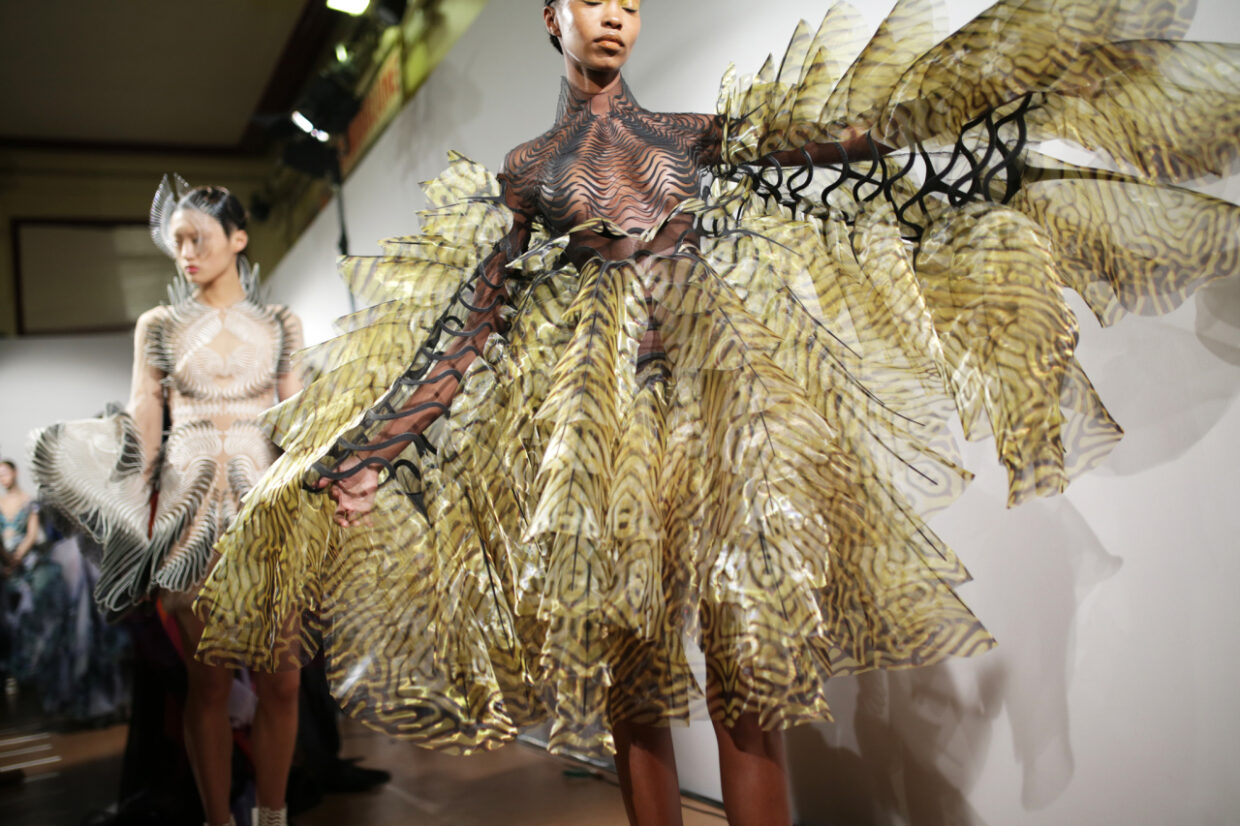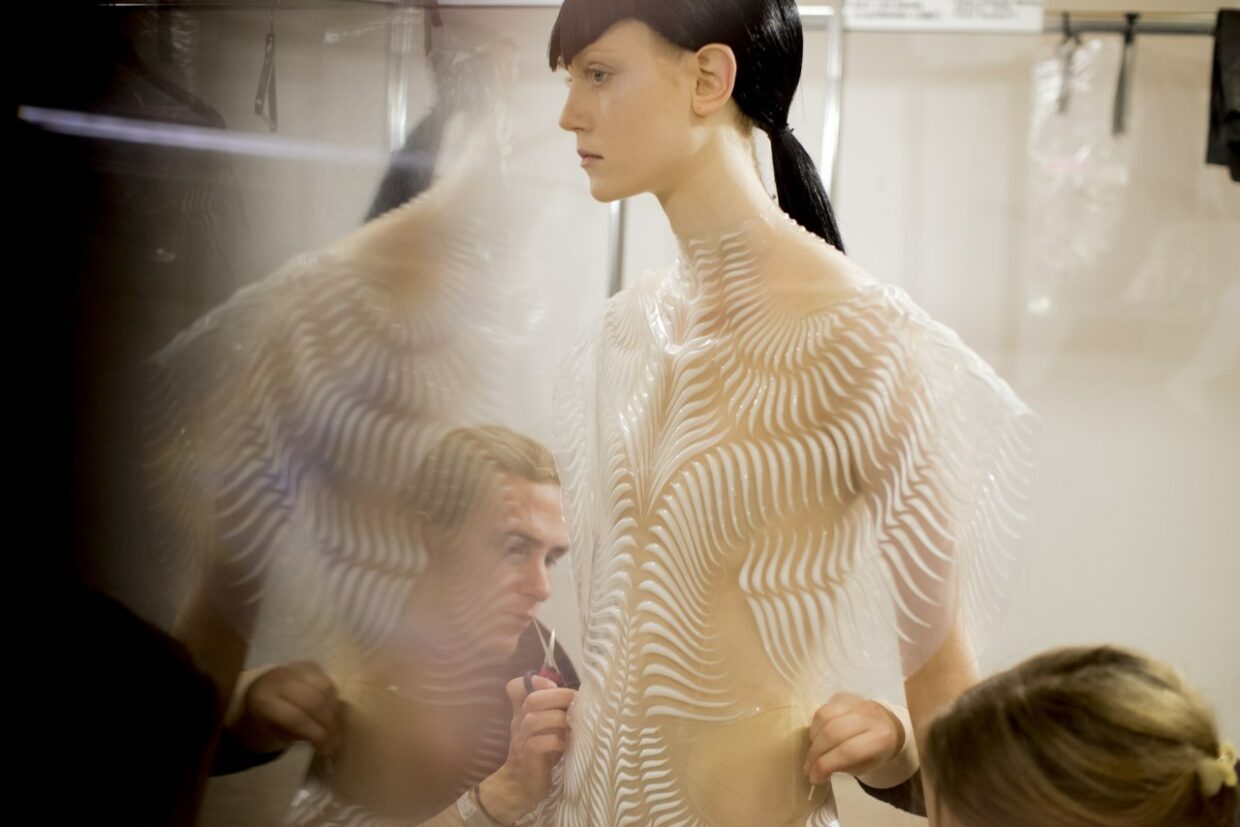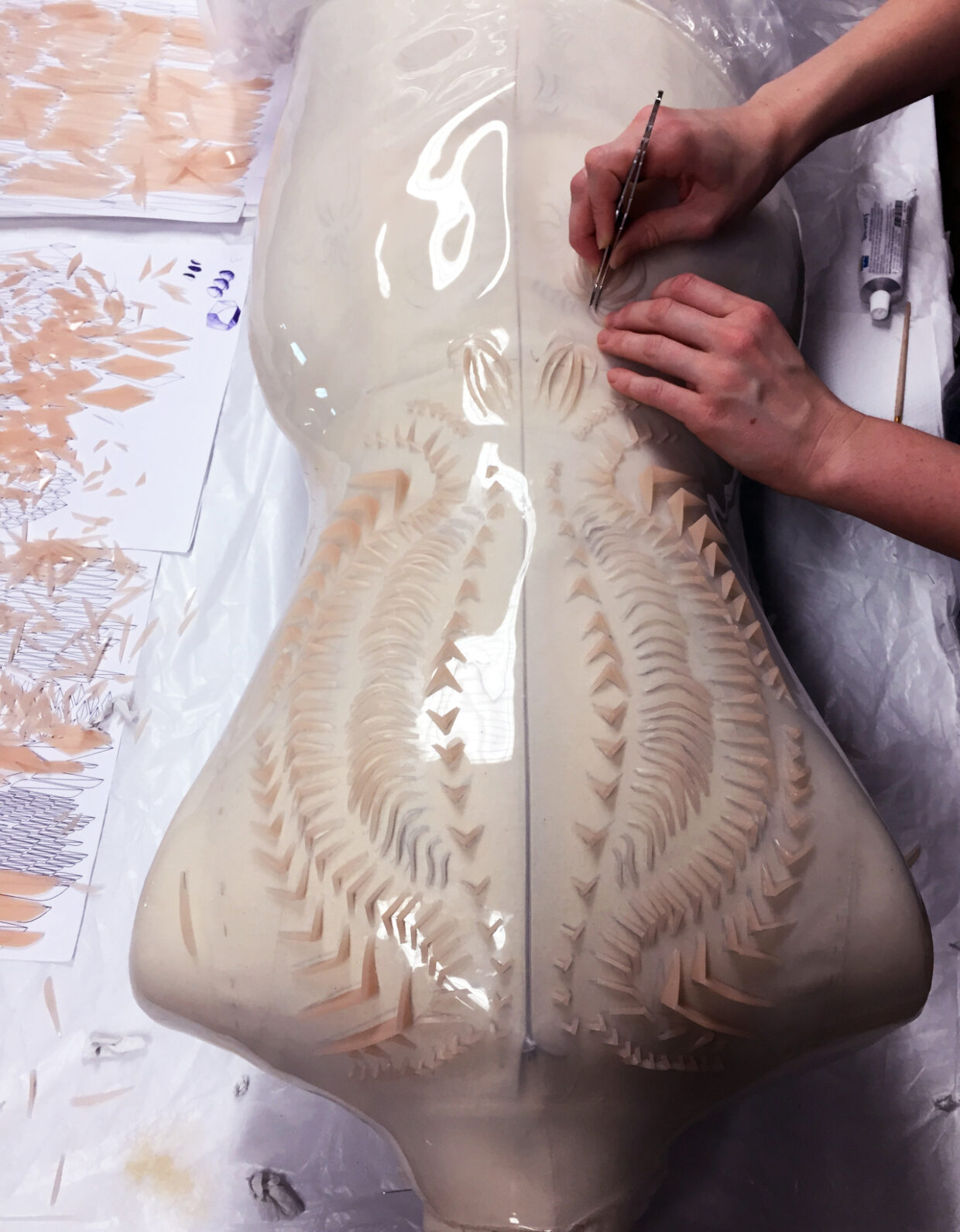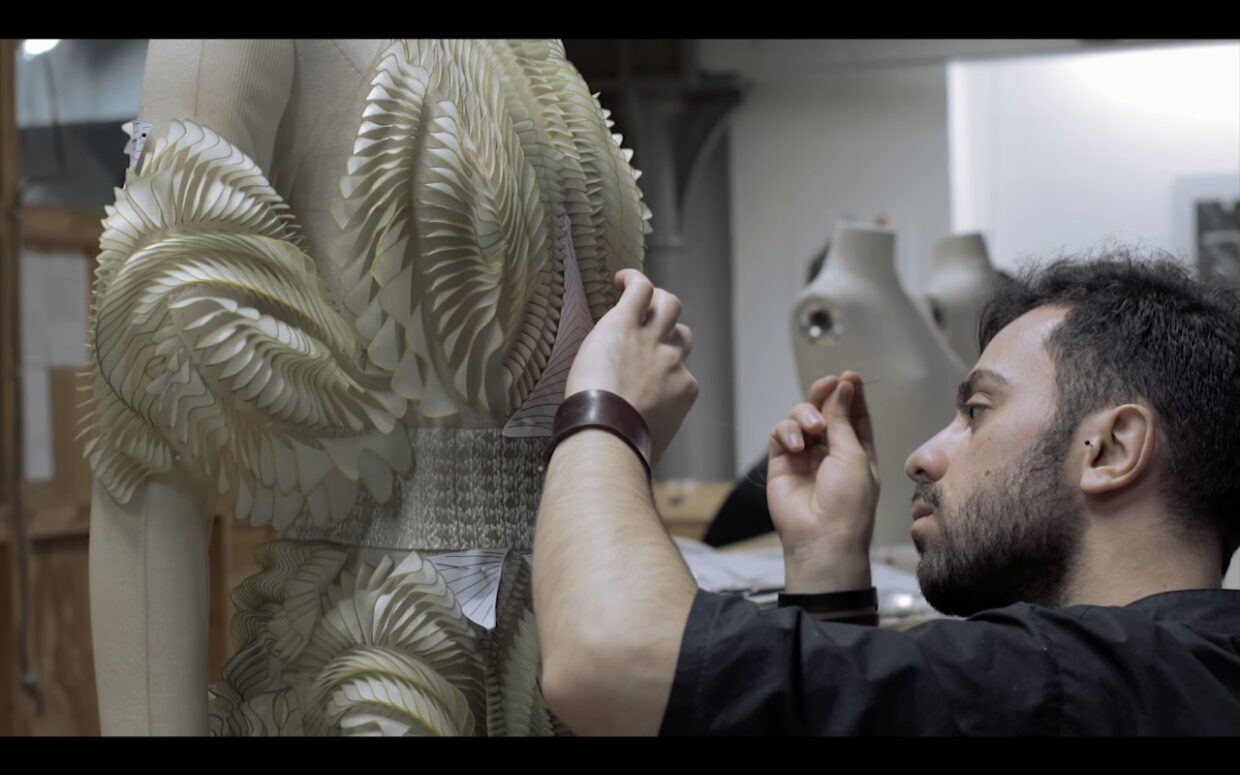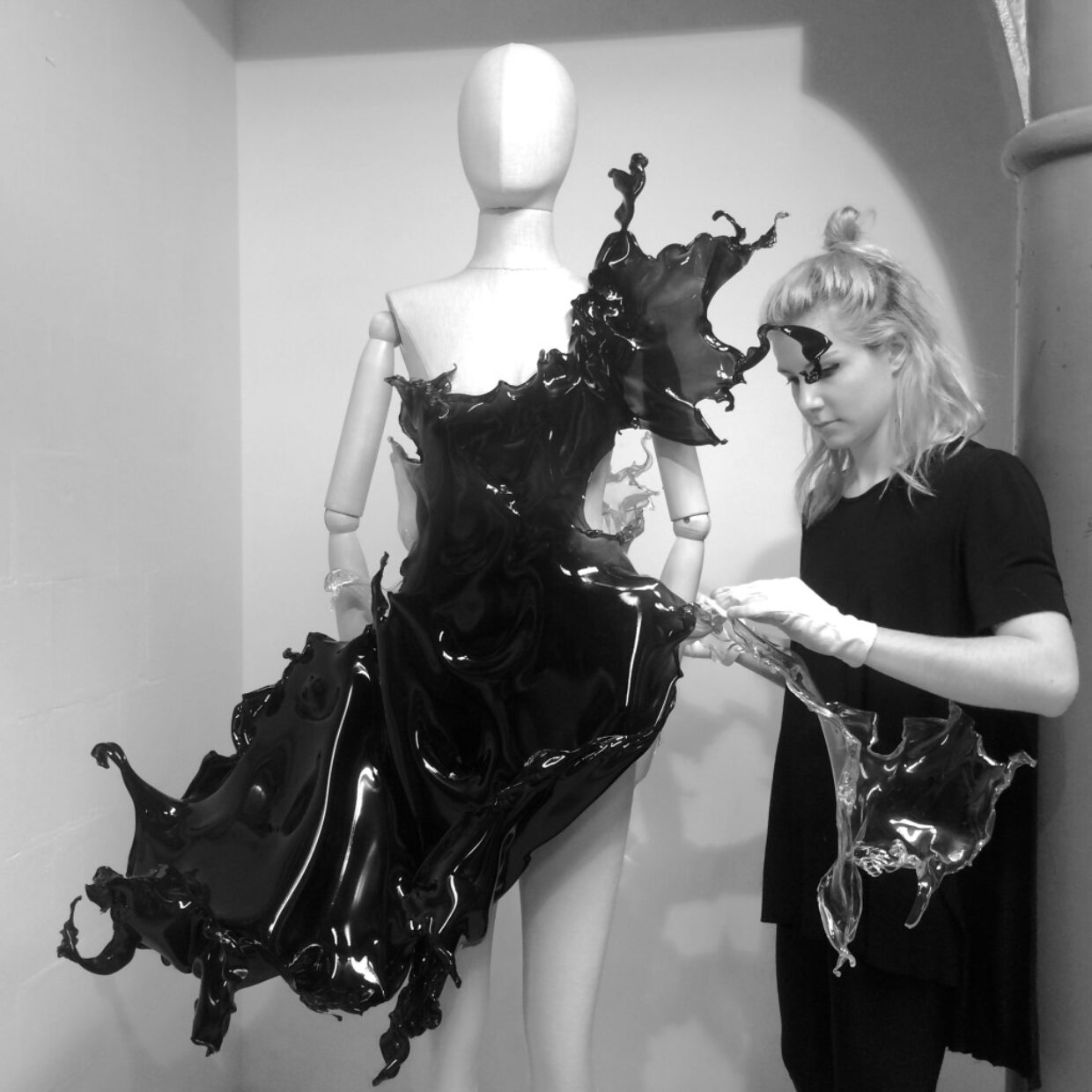Iris Van Herpen Diving Into Virtual Reality
Apr. 9, 2020
As enamored as she is with IRL fashion shows, Iris Van Herpen began preparing for a leap into cyberspace two years ago.
The Dutch couturier is designing her fall 2020 couture collection, and concurrently is plotting an “immersive virtual reality experience” that will allow a broader audience to discover her otherworldly creations.
A pioneer with 3-D printing and design processes, Van Herpen also downloads plenty of poetry and emotion into her designs. Will that translate in the digital realm?
Here, the designer talks about what the future of fashion might look and feel like.
WWD: You’re synonymous with high-tech inspirations and cutting-edge techniques, yet live shows remain your main communication tool. Why is that?
Iris Van Herpen: I come from dance and this physical tension or the 3-D aspect of my work is so prominent and such a drive in my work. And that is really experienced beautifully within a physical runway show.
There’s a certain energy of being together, I guess a sense of celebration. Of course there are downsides: You naturally exclude people because of the selection of time and space.
I think the physical presentation is something that we will continue doing at the moment, but I believe fashion needs to have less of them because I think the amount of shows that is happening is just not sustainable for our future. Digital platforms are creating different possibilities.
WWD: What else do you like about IRL fashion shows?
I.V.H.: It’s really the human aspect of it, the impact of a physical presence, of being all together. It’s like a live concert, the magic of how you feel the music. It’s comparable to how you can actually feel a garment when you see a fashion show. It’s chemical I guess, it’s a chemical interaction and that’s something that of course will be different in virtual reality.
On the other hand, there’s tons of possibilities and a certain creativity and freedom to transform reality in the digital sphere and that’s something I’m really eager to explore. I think the two can enhance each other and complement each other.
WWD: Couture week in July has been canceled, so it seems an opportune time to experiment digitally.
I.V.H.: It’s an interesting moment to dive into it even further. In the physical world, my work is already such a challenge. I challenge materiality to the max.
In the virtual world, it’s really hard to capture the movement, transparency and the intricacy in all its detail. But it’s getting there. The technology is evolving, and that’s why it’s a really good moment to take that step.
WWD: Can you talk a little more about the immersive virtual reality experience you’re developing?
I.V.H.: We are doing it simultaneously as we are working on a new collection. It’s just slower and a bigger challenge because we are doing it from home.
At the same time, we are creating a VR experience of that same work. It really is a test to be honest. It’s the first time we will be doing it this way. It’s an experiment for us to get as close to the materiality and the emotion and the three-dimensionality that is important in my work.
WWD: Do you see digital shows as democratizing fashion in a way?
I.V.H.: So much of my audience only experiences my work on my web site or Instagram. The three-dimensionality and true emotion of the work is not being experienced by everybody. I’m really excited by the possibility of bringing a more three-dimensional and emotional experience of the work to a much broader audience.
WWD: Can you talk a little bit about your techniques? Do you sew, sketch, drape, design on computers?
I.V.H.: It’s a mix of all you just mentioned. Some details are sketched, others are designed in 3-D in Maya or Rhino, a lot of it is done in Illustrator for technical files. Some scripting is also done in Grasshopper. We have a mix of programs to work with and often these are used in the early stages of the design process.
Often people ask me, “Is it hand-made or 3-D-printed?” Today the answer is often mixed. It’s really a process of different programs and in the end hand-work as well.
WWD: Do you think digital formats for fashion have a better chance of wide adoption now given the coronavirus pandemic, and the social distancing and travel restrictions it has brought?
I.V.H.: I think this is a really important moment for all of us. It will really create a shift in the choices we’ll make, in the way we produce, the way we travel, the way we do our shows, the way we do our shoots. I think the focus on sustainability is going to become bigger and bigger.
WWD: How digital are you in the design process?
I.V.H.: The 3-D printing is of course a good example because when we 3-D print, we need to draw everything, every millimeter in 3-D. Often Rhino is used for that. It depends on what printer we choose to print on.
That is also interesting for the virtual reality. For a lot of the garments, we have 3-D files in all of their detail already so it’s interesting to translate that to the new reality as well.
WWD: Does this give you a head start moving to the digital world?
I.V.H.: I’m in the process of doing some experiments with animators and it’s an interesting dialogue because within my physical work, within the garments, it’s always that immateriality that I’m ultimately looking for, that fluidity, this sense of not fixed materiality. And there is such a new level of freedom within the virtual world that it’s often hard to stay in my usual design process.
I’m really fascinated by the idea that this new platform will probably influence my design process itself. It’s not only going to be a new platform — it’s going to be a design language. It’s going to be an interesting play where we have this layer in between the reality and the virtual reality.
WWD: Do you think you’ll be able to transpose the emotion of a physical fashion show into the digital sphere?
I.V.H.: Ultimately, yes, but it needs time. A new tool always needs to be explored. It’s like learning to play a new instrument. It will take time before you can put your own language into that new tool, but I do feel we’ll be able to transmit that emotional aspect of the garment into the virtual reality.
WWD: And what about the craftsmanship?
I.V.H.: Virtual reality is going to be a really great platform to translate the beautiful process of a couture atelier. What we do now is limited in a way. Someone films some moments in the atelier and we share the process video.
There’s so much love and emotion already going into that process and that’s something really great to share with your audience, especially with haute couture, the hours that go into one piece, and the different levels of craftsmanship and expertise, especially within our work: It’s collaboration between architecture and science and biology and not a lot of that is really expressed or possible to share with people at this moment.
I really hope we can bring some of that into a VR experience, where people really can be in the atelier with us for a moment and see the evolution of a garment that is growing in front of their eyes. I think we’ve just started to see the possibilities.
A lot of people still have no idea how the garments are made. I really think I’ll be able to share a lot more in the near future by embracing these new tools.
WWD: What other industries do you look to for inspiration and new possibilities?
I.V.H.: Inspiration and also collaborations is coming from different areas. Architecture is an industry that we work with a lot, but we are also in contact with universities, tech companies, biologists, scientists. It’s really a mix of these that go into the work and these conversations are ongoing and a really important part of the process.
WWD: Where do you think this is all heading? Are we on the cusp of an acceleration toward the fashions of the future?
I.V.H.: I personally think fashion can intertwine so much more with the world around her. I really believe that fashion can start really embracing collaboration in a wide scope. We should really start looking at collaborating with science, and of course with technology to really make steps in sustainability on a large scale.
I want to show that haute couture is a really important part of fashion. It can really provide a laboratory of sustainability, and can be a source of development and experimentation of discovering new future possibilities of change.
I personally think the development within materials and also production has so much more potential than what’s being explored today. I think speed of the industry has not helped progress at all. That’s why this moment of standing still is actually an important one to see that we can really collaborate and work together to find new materials, and also new production techniques for a more sustainable future.
I really hope that people embrace this moment and start looking for alternatives and start looking for collaborations, even between companies and between brands. I think fashion should act more like a community. I think that will also really help moving forward within the sustainability. I don’t think we should all start only changing ourselves; we should start conversations all together.
Source: WWD
